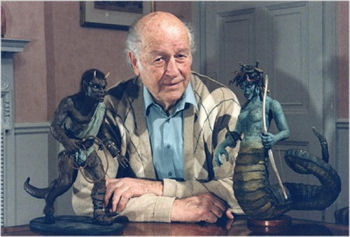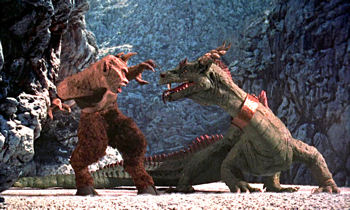|
Ray Harryhausen
1920-2013 Once, there was magic in making things move on film. Animation had been a staple of filmmaking from the Silent Era onwards. It seemed like every time a new animation film came out, a new generation would pop up just a few years later that would completely take their inspiration from that film. King Kong, perhaps the greatest of all the effects films of its time, led to a generation of animators interested in using realistic miniature models to create effects in films with live action footage.
Ray Harryhausen, arguably the greatest of all stop-action model animators of them all, came out of those brought to the idea by Willis O'Brien's work on King Kong. He passed away on May 7th at the age of 92.
After seeing King Kong almost obsessively as a kid, he began experimenting in making stop-motion shorts, mostly science fiction movies. He got to meet Willis O'Brien, his hero, and showed him his early models. The story goes that O'Brien pulled no punches, but saw some promise and told him to get some graphic arts training to improve him results. He studied sculpture and became a master at the craft.
In the 1930s, Harryhausen met a young writer who was also just getting started. His name was Ray Bradbury. The pair of them became close friends, and the two of them joined up with a group called The Science Fiction League of Los Angeles. It had been formed by a dude named Forrest J Ackerman, best known as Forry. The three of them, Ray, Ray, and Forry, became three of the best-known members of what the Science Fiction League of Los Angeles would become: The Los Angeles Science Fantasy Society, LASFS.
During this time, the teenaged Harryhausen made a few shorts, including Cavebear, a story of a cavebear attacking his dog, Kong. I believe this is the oldest surviving film of Harryhausen's work, and also his first full film. This appears, along with a great many other early Harryhausen pieces, on the amazing Ray Harryhausen Early Years Collection
Harryhausen's first official paying gig was working for George Pal on his series of Puppetoons. He got the job by showing footage from the film he had been trying to make: Evolution of the World. The film was going to be a feature-length animated documentary about how evolution ran, meant to be shown in schools.
He started working on one section before any of the others - the section on the dinosaurs. This footage, early test work, and a few of the models built to create it, still exists and is some of the most significant surviving from the era. During WWII, Ray made films for the US Army Signal Corps, one of which, How to Build a Bridge, was done to show how training films could be made using stop-motion. He also worked on the series Why We Fight, a project under the direction of Frank Capra. In particular, he worked under John Huston to make Let There Be Light, which many film historians consider to be one of the finest wartime documentaries ever made (and strangely, can be found as an extra on the blu-ray of The Master. - editor)
Willis O'Brien hired Ray to work on Might Joe Young. The effects were revolutionary, and Ray followed that up with attempts at several SciFi films, including Food of the Gods and War of the Worlds. With the possible exception of Orson Welles, no other filmmaker I can think of had as many unrealised films. Such is the problem of living on the bleeding edge.
But the ones that actually got made were spectacular.
He created the effects for The Beast from 20,000 Fathoms, and later IT CAME FROM BENEATH THE SEA. He teamed with O'Brien again to work on Irwin Allen's The Animal World. He was getting regular work making remarkable animations, though everything would sort of explode with his work on The 7th Voyage of Sinbad.
Many filmmakers of the 1970s and 80s point to this as the film that inspired them to go into film, most notably a fellow named John Landis, though others like Peter Jackson, Tim Burton, and Nick Parks of Aardman Animation all point at it as well. This was the start of a string of films that are always considered to be Harryhausen pictures, no matter who directed, wrote, or starred in them.
It was Ray's visions that made films like Jason & The Argonauts, The Valley of Gwangi, The Golden Voyage of SInbad, and especially Clash of the Titans. It was at a panel on Clash of the Titans that I first heard Ray speak about movies, about how he approached effects. It was almost certainly at the 1984 WorldCon in Anaheim that I first saw the Three Old Friends, Harryhausen, Bradbury, and Ackerman, on a panel together, telling stories of the old times. The three of them appeared together many times, even after Harryhausen moved to London. The stories they'd tell, some of which might even have been true, told of what it was like around the beginning of LA Science Fiction fandom and those that moved through it.
|
|
|
Cyclops vs. Dragon. So much more exciting by Harryhausen than Marvel.
|
Ray also helped the field of Film History. He held on to many of his creations, models and pre-production materials, as well as holding on to unreleased footage. He collected stories, and knew so many of the people involved in genre filmmaking that he was a frequent contributor to DVD Extras.
He consulted on the colorization of Things to Come, the classic English science fiction made with a script by H.G. Wells himself. Many are leery of colorizing films, but when Ray Harryhausen says it's what the filmmakers wold have done if they had the money, people listen. His commentary on the film makes purchasing that DVD well-worth the money. In 1986, Ray and his wife founded The Ray & Diana Harryhausen Foundation to preserve not only the items from his collection, but Ray's role in the world of film.
Ray appeared in a few movies too, as did his buddies Forry and Bradbury. He appeared in Spies Like Us, Beverly Hills Cop III (in which I was also an Extra!), and even Elf, where Ray voiced a polar bear cub. He had a brief appearance in Comic Book: The Movie as well. He appeared several times on Creature Features here in the Bay Area, most notably in a segment with Bob Wilkins about an upcoming convention in Oakland. His films were also regularly featured on the show.
Perhaps his greatest legacy isn't so much the movies, of which his effects were only a part of, but the iconic images that he gave us. Whether it's the advancing skeletons that scared the hell out of me as a kid from Jason and The Argonauts or the Cyclops from The 7th Voyage of Sinbad or Bubo from Clash of the Titans. All of these have sunk deep into the language of popular culture and you can find references to them in everything from Robot Chicken and Family Guy, to old MTV promos and insurance commercials.
The last time I saw Ray Harryhausen would have been about 2006. He didn't make it to the LA WorldCon, where I had to settle on being enthralled by just Forry and Bradbury for an hour, and shaking Forry's hand and saying 'Thank you' for all he had done for me. I know I saw him before that, because I asked him if he'd be at WorldCon and he said no. He was as kind and funny a guy as I could have imagined. Just like Forry. Just like Bradbury.
And sadly, now they're all gone.
|







